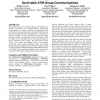Free Online Productivity Tools
i2Speak
i2Symbol
i2OCR
iTex2Img
iWeb2Print
iWeb2Shot
i2Type
iPdf2Split
iPdf2Merge
i2Bopomofo
i2Arabic
i2Style
i2Image
i2PDF
iLatex2Rtf
Sci2ools
104
click to vote
NGC
2000
Springer
2000
Springer
The use of hop-limits to provide survivable ATM group communications
We examine the use of a hop-limit constraint with techniques to provide survivability for connection-oriented ATM group communications. A hop-limit constraint is an approach that has evolved from solving point-to-point routing problems but has not been fully developed for group communications. A hop-limit: (1) limits the number of routes considered such that the routing problems of higher order complexity can be solved and (2) limits the length of any individual route to meet specific Quality of Service guarantees (such as delay). This paper focuses on the former. We compare the feasibility and cost of providing survivability using working multipoint routes with disjoint dedicated backup multipoint routes, where the multipoint routes are setup using either Self-Healing Rings, Shared Multicast Trees, or VC Meshes. We found that hop-limit constraints allowed us to exactly solve NP-complete routing problems on real networks. Categories and Subject Descriptors B.8.1 [Performance and Relia...
Related Content
| Added | 25 Aug 2010 |
| Updated | 25 Aug 2010 |
| Type | Conference |
| Year | 2000 |
| Where | NGC |
| Authors | William Yurcik, David Tipper, Deep Medhi |
Comments (0)

